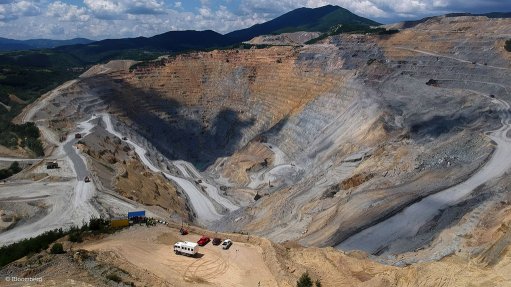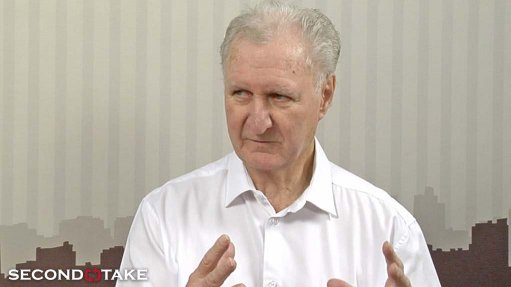Venetia Underground Project, South Africa – update


Name of the Project
Venetia Underground Project (VUP).
Location
Venetia mine, in Limpopo, South Africa.
Project Owner/s
Anglo American subsidiary De Beers Consolidated Mines.
Project Description
The Venetia mine, which officially opened on August 14, 1992, is currently the biggest producer of diamonds in South Africa.
The mine is an openpit operation; however, following shareholder approval, development work began in late 2013 to build the new underground mining operation beneath the current operating openpit. It is currently the biggest diamond mine development under way anywhere in the world.
The VUP will extend the mine life by 23 years to 2046.
At steady-state production, 5.9-million tonnes of ore will be treated through the existing process plant to produce about 4.5-million carats of diamonds a year.
Scheduled inferred resources (39.3-million tonnes) constitute 25% (23.6-million carats) of the estimated carats. This will extend the life of the Venetia mine to 2045 and replace the openpit production from 2022.
The Venetia project comprises the K01 and K02 orebodies. Both kimberlites extend below surface, enabling De Beers to mine to depths of up to 1 000 m. There are indications that K01 extends below 1 000 m, and De Beers may explore options that extend the underground operation’s life beyond 2045.
K01 – a sizeable orebody measuring 550 m x 120 m – will be responsible for the majority of production, generating an average of 3.5-million carats from about 4.5-million tonnes a year of material.
The K02 orebody – measuring 200 m x 300 m – will provide the balance, producing about one-million carats from 1.5-million tonnes to 2.5-million tonnes a year of material.
The current mining solution for the underground project will use sublevel caving to extract material from both orebodies. Further optimisation studies are being completed to determine whether the K02 orebody should be mined using a block cave mining methodology.
Underground infrastructure comprises two vertical shaft systems for personnel transport, ore transport and the routing of services, as well as lateral access to levels on the 54L, 91L and 94L stations for the services shaft and on the 100L station for the production shaft.
The service shaft has a finished internal diameter of 7 m and will eventually provide all the services and people transport for the underground workings, while the production shaft, also with a finished internal diameter of 7 m, will be fitted with two rock winders, each having two 24 t payload skips.
The service and production shafts will serve as downcast air intakes to the underground workings, while a decline and pit ramp will assist with early underground access for the construction of the production infrastructure for K01 and K02, which will be developed concurrently to the vertical shafts.
They will also serve as an additional air intakes and logistical access points, which VUP says will mitigate the immediate requirement for the use of the shafts for ground handling.
Overall, VUP will undertake 61.5 km of initial excavations as part of the expansion project, as well as a further 177 km of excavations over the remainder of the underground life-of-mine.
Surface infrastructure, which includes change houses, a heat tolerance testing centre, a lamp room, a proto room, a control room, winder houses, workshops, warehouses, ventilation systems and a state-of-the-art training facility, were completed in early 2021.
De Beers also plans to have Venetia operating as carbon neutral by 2030; using battery electric vehicles (BEVs) and installing a 60 MW solar photovoltaic (PV) plant are expected to help achieve that goal.
The ultimate sizing of the energy plant is yet to be finalised.
Potential Job Creation
During construction, employment will peak at about 2 200 personnel. The workforce currently comprises 1 800 people.
Net Present Value/Internal Rate of Return
Not stated.
Capital Expenditure
De Beers plans to invest about $2.1-billion in the VUP until 2026. Anglo American noted in its results for the six months ended June 30, 2021, that $1.2-billion remained to be spent.
Planned Start/End Date
The VUP is targeting first production by late 2022 and a ramp-up to full production from 2024 onwards.
Latest Developments
The VUP is nearing 54% completion.
While the miner’s budget and targets were set in place before the Covid-19 pandemic, VUP project director Allan Rodel has stated the miner’s site team has “done a fantastic job” in recovering some of the losses of the past two years.
The project is also expected to remain within budget.
However, during the past 18 months, Rodel has said that the VUP has achieved a 280% improvement in mining development rates.
The miner is now targeting to double the development rates at the top-of-mine within the next 12 months, while the bottom-of-mine is targeted to double capacity within the next nine months. This will allow for first production in the fourth quarter of 2022.
De Beers has said that using technology is critical in building the mine of the future, and will ensure the safety of its people and create unique employment opportunities.
This is as a result of a technological collaboration between De Beers and engineering group Sandvik Mining and Rock Solutions, through which the successful implementation of technology “holds the key to further improve the mine’s productivity and cost effectiveness, enabling the quality and accuracy required for precision mining”.
The technology will also enable the miner to provide real-time geospatially referenced data that supports digitalisation of processes and provides a wealth of data for analysis and continuous improvement.
This is in line with De Beers Group’s goal of achieving carbon neutrality at its mines in Botswana, Canada, Namibia and South Africa, as well as at its other operations across the diamond pipeline worldwide.
De Beers carbon neutrality head Kirsten Hund previously told Mining Weekly that the group aimed to optimise energy efficiency across all operations, introduce clean-fuel equipment and green electricity generation, and ensure nature-based carbon absorption programmes.
Further, Rodel has explained that the proposed 60 MW solar PV plant at Venetia mine will largely be used for power generation during the day. Storage options will be considered at a later stage and will be aligned with the Anglo American regional and national programme.
There is also potential to expand the solar PV plant in future.
De Beers is finalising operational and funding models given the national/regional approach to alternative energy production. Construction will start once study work and all permitting have been completed.
Key Contracts, Suppliers and Consultants
Murray & Roberts Cementation (development of underground mine); and Redpath Australia (development of the underground mine with the De Beers team, working as the integrated owners team).
Worley, BMH, BBE, ABB, Grinaker and Louwill are among the contractors involved in the project.
Contact Details for Project Information
De Beers Group Managed Operations senior communications manager Jackie Mapiloko, tel +27 11 374 7173 or email jackie.mapiloko@debeersgroup.com.
Comments
Press Office
Announcements
What's On
Subscribe to improve your user experience...
Option 1 (equivalent of R125 a month):
Receive a weekly copy of Creamer Media's Engineering News & Mining Weekly magazine
(print copy for those in South Africa and e-magazine for those outside of South Africa)
Receive daily email newsletters
Access to full search results
Access archive of magazine back copies
Access to Projects in Progress
Access to ONE Research Report of your choice in PDF format
Option 2 (equivalent of R375 a month):
All benefits from Option 1
PLUS
Access to Creamer Media's Research Channel Africa for ALL Research Reports, in PDF format, on various industrial and mining sectors
including Electricity; Water; Energy Transition; Hydrogen; Roads, Rail and Ports; Coal; Gold; Platinum; Battery Metals; etc.
Already a subscriber?
Forgotten your password?
Receive weekly copy of Creamer Media's Engineering News & Mining Weekly magazine (print copy for those in South Africa and e-magazine for those outside of South Africa)
➕
Recieve daily email newsletters
➕
Access to full search results
➕
Access archive of magazine back copies
➕
Access to Projects in Progress
➕
Access to ONE Research Report of your choice in PDF format
RESEARCH CHANNEL AFRICA
R4500 (equivalent of R375 a month)
SUBSCRIBEAll benefits from Option 1
➕
Access to Creamer Media's Research Channel Africa for ALL Research Reports on various industrial and mining sectors, in PDF format, including on:
Electricity
➕
Water
➕
Energy Transition
➕
Hydrogen
➕
Roads, Rail and Ports
➕
Coal
➕
Gold
➕
Platinum
➕
Battery Metals
➕
etc.
Receive all benefits from Option 1 or Option 2 delivered to numerous people at your company
➕
Multiple User names and Passwords for simultaneous log-ins
➕
Intranet integration access to all in your organisation


















